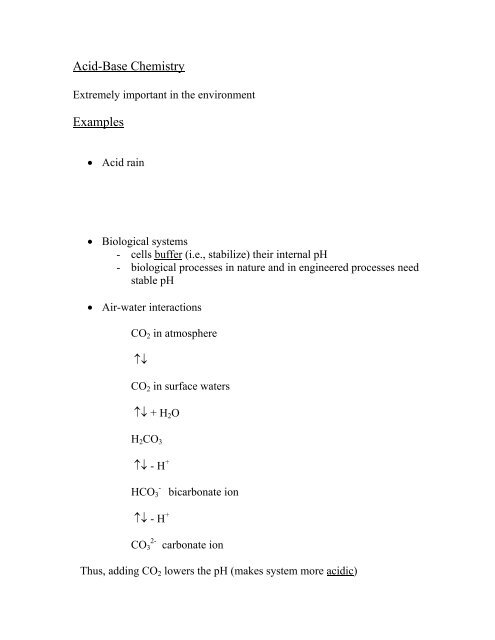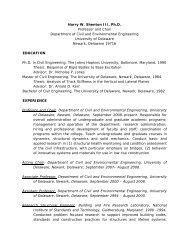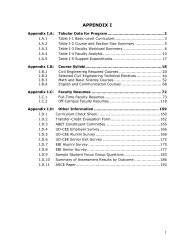Acid-Base Chemistry Examples - Civil and Environmental Engineering
Acid-Base Chemistry Examples - Civil and Environmental Engineering
Acid-Base Chemistry Examples - Civil and Environmental Engineering
Create successful ePaper yourself
Turn your PDF publications into a flip-book with our unique Google optimized e-Paper software.
<strong>Acid</strong>-<strong>Base</strong> <strong>Chemistry</strong><br />
Extremely important in the environment<br />
<strong>Examples</strong><br />
• <strong>Acid</strong> rain<br />
• Biological systems<br />
- cells buffer (i.e., stabilize) their internal pH<br />
- biological processes in nature <strong>and</strong> in engineered processes need<br />
stable pH<br />
• Air-water interactions<br />
CO 2 in atmosphere<br />
↑↓<br />
CO 2 in surface waters<br />
↑↓ + H 2 O<br />
H 2 CO 3<br />
↑↓ - H +<br />
HCO 3<br />
-<br />
bicarbonate ion<br />
↑↓ - H +<br />
CO 3<br />
2-<br />
carbonate ion<br />
Thus, adding CO 2 lowers the pH (makes system more acidic)
• <strong>Acid</strong> mine drainage – Coal contains reduced sulfur <strong>and</strong> acid mine<br />
drainage has long been an environmental problem. Much of this<br />
sulfur is contained in pyrite, FeS 2 , a common mineral. On exposure to<br />
the air it oxidizes giving ferric, sulfate <strong>and</strong> hydrogen ions:<br />
FeS 2 + 15/4 O 2 + 1/2 H 2 O ↔ Fe 3+ + 2 SO 4 2- + 2 H +<br />
The ferric ions undergo a hydrolysis reaction with water liberating more<br />
protons (thus making the system even more acidic) <strong>and</strong> precipitating ferric<br />
hydroxide (“rust”) on the stream bottom <strong>and</strong> banks.<br />
Fe 3+ + 3 H 2 O ↔ Fe(OH) 3 (s) + 3 H +<br />
• A treatment question – Most metals (e.g., Fe, Cu, Zn etc) come from<br />
open-pit mines using large equipment for processing. After removal<br />
of the metals from the finely crushed rock the residual “tailings” are<br />
disposed in piles or disposal areas. The residual sulfide will, over<br />
time, oxidize causing the material to become acidic <strong>and</strong> thus leaching<br />
metals into surface <strong>and</strong> ground water. To prevent this potential<br />
contamination, limestone (CaCO 3 ) is added to neutralize the released<br />
hydrogen ions. Can you calculate the amount of limestone that would<br />
have to be added if, for instance, the waste material had been found to<br />
contain 4% S?
Consider the reaction<br />
H 2 O ↔ H + + OH -<br />
<strong>Base</strong>d on the definition of K<br />
+ -<br />
{ H }{ OH }<br />
1000 g<br />
~<br />
K =<br />
⇒ concentration of H 2 O: L<br />
= 55.5 mol/L<br />
18g/mol<br />
{ H O}<br />
2<br />
But<br />
Define {H 2 O} = 1<br />
In a dilute system { } = [ ]<br />
K w = [H + ] [OH - ]<br />
at 25°C, K w = 1.0 × 10 -14<br />
[H + ] [OH - ] = 10 -14<br />
When are they equal? [H + ] = [OH - ] = (10 -14 ) 1/2 = 10 -7<br />
But in an acidified lake<br />
[H + ] = 10 -4 ; [OH - ] = 10 -14 /[H + ] = 10 -14 /10 -4 = 10 -10<br />
Range of concentrations is orders of magnitude.<br />
So – define “p” = “-log 10 ”<br />
pH = -log 10 [H + ]<br />
pOH = -log 10 [OH - ]<br />
So we don’t always have to deal with negative values - if we just use logs<br />
Note the – sign: as [H + ] increases, pH decreases<br />
pH 7 [H + ] = 10 -7 [OH - ] = 10 -7<br />
pH 4 [H + ] = 10 -4 [OH - ] = 10 -10<br />
Convert the equilibrium expression<br />
-log 10 ([H + ] [OH - ]) = -log 10 [H + ] + -log 10 [OH - ] = -log 10 K w<br />
= pK w = -log 10 10 -14 = 14<br />
<strong>and</strong><br />
-log 10 [H + ] + -log 10 [OH - ] = 14<br />
so<br />
pH + pOH =14<br />
It is useful to consider log – log plots of concentration
0<br />
2<br />
log [H + ]<br />
log [OH - ]<br />
4<br />
10 -4<br />
- log C = pC<br />
6<br />
8<br />
10<br />
10 -10<br />
pH 7<br />
[H + ] = [OH - ]<br />
12<br />
14<br />
0 2 4 6 8 10 12 14<br />
pH --- "Master Variable"<br />
We can treat acids <strong>and</strong> bases in a similar manner<br />
Definitions<br />
<strong>Acid</strong> can donate H + (proton)<br />
<strong>Base</strong> can accept H +<br />
Generic acid “HA”<br />
HA ↔ H + + A - (dissociation)<br />
A strong acid (HCl – hydrochloric, HNO 3 – nitric, H 2 SO 4 – sulfuric, but only<br />
first proton) is one for which the dissociation is complete in water<br />
If the dissociation is
We can so the same thing we did for H 2 O:<br />
HA ↔ H + + A -<br />
+ -<br />
[ H ][ A ]<br />
K = = "acidityconstant"<br />
(eqn 1)<br />
a<br />
[ HA]<br />
Example acetic acid CH 3 COOH = “HA”<br />
<strong>and</strong> acetate ion CH 3 COO - = “A - ”<br />
pK a = 4.7, K a = 10 -4.7 = 2.0 × 10 -5<br />
Put 10 -4 mol CH 3 COOH in 1 L solution. What is the pH?<br />
Is this a strong acid?<br />
+<br />
-<br />
5 [ H ][ CH3COO<br />
]<br />
From equation 1: 2×<br />
10<br />
− =<br />
−5<br />
+ 2×<br />
10<br />
<strong>and</strong> [ ]<br />
[ CH3COOH]<br />
H =<br />
-<br />
[ CH3COO<br />
]<br />
[ CH ]<br />
3COOH<br />
we could solve for<br />
-<br />
[ CH COO ]<br />
What else do we know? 10 -4 M!<br />
3<br />
[ CH COOH]<br />
3<br />
but we would still need another equation.<br />
[CH 3 COOH] + [CH 3 COO - ] = 10 -4 = C T (eqn 2)<br />
Combining eqn 1 <strong>and</strong> eqn 2 gives<br />
<strong>and</strong><br />
+<br />
[ HA] [ H ]<br />
=<br />
+<br />
CT<br />
K a + [ H ]<br />
-<br />
[ A ] K a<br />
=<br />
+<br />
CT<br />
K + [ H ]<br />
a<br />
(eqn 3)<br />
(eqn 4)<br />
We will use these instead of solving directly for [H + ]. The two equations<br />
generate a useful graph (see Appendix p 9 for mathematical details).
0<br />
-log C = pC<br />
2<br />
4<br />
6<br />
8<br />
log C T<br />
CH 3<br />
COO -<br />
CH 3<br />
COOH<br />
10<br />
0 2 4<br />
pK a 6 8 10 12 14<br />
pH<br />
This graph shows the concentration of the CH 3 COOH (protonated) species<br />
<strong>and</strong> CH 3 COO - (dissociated) species at any pH. Note that at a low pH, the<br />
protonated species is predominant, but at higher pH, the dissociated species<br />
predominates.<br />
Notice that when the pH equals the pK a , the CH 3 COOH <strong>and</strong> CH 3 COO -<br />
concentrations are equal.<br />
Because a strong acid completely dissociates to A - , the pK a would have to be<br />
very low.<br />
At any pH below 4.7, acetic acid is less than 50% dissociated. It is a weak<br />
acid. A strong acid would have to have a very small pK a . Actually, their<br />
values are negative!<br />
So now we know that acetic acid is a weak acid. But we never figured out<br />
where we were on the log C – pH diagram (i.e., the pH after adding 10 -4 M<br />
acetic acid to the H 2 O).<br />
We need another equation. There are two that can be used, either a charge<br />
balance or a proton condition. In this course we’ll just use the charge<br />
balance which simply says that the total negative charge in the system must<br />
equal the overall positive chare (“electroneutrality”).<br />
We add the concentrations of all anions on one side of the equation, cations<br />
on the other. In our example
[H + ] = [H 3 CCOO - ] + [OH - ]<br />
We finish our problem by combining our acetic acid graph with our previous<br />
graph for [H + ] <strong>and</strong> [OH - ], <strong>and</strong> look for a pH where the [H + ], [H 3 CCOO - ], <strong>and</strong><br />
[OH - ] lines satisfy the above condition.<br />
0<br />
2<br />
4<br />
H +<br />
CH 3<br />
COO -<br />
OH -<br />
-log C = pC<br />
6<br />
8<br />
10<br />
CH 3<br />
COOH<br />
12<br />
14<br />
0 2 4 6 8 10 12 14<br />
pH<br />
You could have plotted -log C as is frequently done. The graph would have<br />
been identical except for the sign of the values on the y-axis. If you draw<br />
the graph by h<strong>and</strong>, you must use graph paper. Preferable is 10 × 10 to the<br />
centimeter (10 × 10 to the inch may also be used).<br />
The solution to the charge balance equation is found by inspection being<br />
careful to consider only the lines of species that are represented in the<br />
electroneutrality equation <strong>and</strong> remembering that the graph shows<br />
logarithmic, not linear, values. The charge balance is fulfilled when pH ≅<br />
4.5, where [CH 3 COO - ] ≅ 10 -4.5 , [H + ] ≅ 10 -4.5 , <strong>and</strong> [OH - ] is so small that it can<br />
be neglected (~10 -9.5 ). So the pH of the acetic acid solution will be 4.5.<br />
So the overall approach is this:<br />
1. Get the pK a . It’s –log 10 K a if you have K a . If you have K b or pK b (the<br />
base dissociation constant), use K b = 10 -14 / K a , or p K b = 14 – p K a .<br />
2. Get C T <strong>and</strong> –log 10 C T (pC T ). C T is the sum of [HA] <strong>and</strong> [A - ] already in<br />
the solution plus the amount added. It must be in moles/L.<br />
3. Draw the graph in the following steps:<br />
a. Draw axes as shown in the example.
. Draw a vertical line at pH = pK a .<br />
c. Draw a horizontal line at –log 10 C T .<br />
d. Locate the intersection from (b) <strong>and</strong> (c) <strong>and</strong> from it, draw lines<br />
downward in each direction at 45°. Also locate a point (x) 0.3<br />
units below this intersection.<br />
e. Draw a line that connects the lower portion of each 45° with<br />
point x <strong>and</strong> then over onto the horizontal C T line. The one<br />
that’s higher at low pH is protonate; the one that is higher at<br />
high pH is dissociated.<br />
f. Now draw the H + <strong>and</strong> OH - lines. These are 45° lines that cross<br />
at pH = 7<br />
4. Write the charge balance (electroneutrality) equation * . Find the<br />
location on your graph where it is satisfied. Usually only one<br />
negatively charged species <strong>and</strong> one positively charged species will be<br />
significant, <strong>and</strong> the others will be low enough to neglect.<br />
5. Once you have this point, it gives you the pH <strong>and</strong> the concentration<br />
(-log 10 concentrations) for all species.<br />
We will stop with this application. But this type of graph can be used to<br />
analyze titrations, precipitation, equilibria with the atmosphere or other gas<br />
phases, <strong>and</strong> mineral equilibria.<br />
* Any species with more than one + or – charge must include this coefficient<br />
in the equation. Remember, it is moles of charge not moles of compound<br />
that is being considered. For example, adding Ca(OH) 2 to H 2 O, we would<br />
write<br />
2 [Ca 2+ ] + [H + ] = [OH - ]
Appendix: How the pC-pH graph is obtained from the equilibrium<br />
equations (eqn. 3 <strong>and</strong> eqn. 4).<br />
1. First consider the low pH region, where pH K a . Equation 4 was<br />
- CTKa<br />
[ A ] =<br />
+<br />
Ka<br />
+ [ H ]<br />
The denominator can now be approximated by [H + ], so taking logs<br />
gives<br />
log 10 [A - ] = log 10 C T + log 10 K a – log [H + ]<br />
p[A - ] = pC T + log 10 K a + pH<br />
which is the 45° line upward * . Also using [H + ] >> K a , eqn. 3 gives<br />
p[HA] = pC T , the horizontal line.<br />
2. Now at high pH, we have [H + ]
















